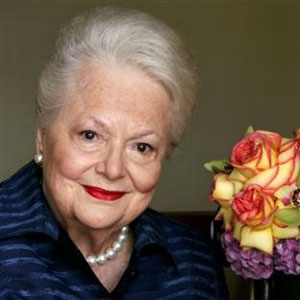Olivia de Havilland starb mit 104 Jahren am 27. 7. 2020. Sie war eine der schönsten Frauen des amerikanischen Films und eine der bezauberndsten Diven Hollywoods. Sie lebte zum Schluss in Paris (seit 1953) und feierte dort 2016 ihren 100. Geburtstag im Kreis ihrer Familie, bzw. der Familie ihres vierten Mannes, Pierre Galante. Nachstehend ein Auszug aus einem Artikel des Santa Monaca Observers zu diesem Anlass. Wir als Fans von Film und Musik trauern, auch wenn Olivia de Havilland unseres Wissens nicht gesungen hat und eigentlich nicht in unsere Sparte „fällt“… G. H.
After romantic relationships with Howard Hughes, James Stewart, and John Huston, de Havilland married author Marcus Goodrich, with whom she had a son, Benjamin. Following her divorce from Goodrich in 1953, she moved to Paris and married Pierre Galante, an executive editor for the French journal Paris Match, with whom she had a daughter, Gisèle. In 1962 she published Every Frenchman Has One, an account of her life in France. De Havilland and Joan Fontaine are the only sisters to have won Academy Awards in a lead acting category. A lifelong rivalry between the two resulted in an estrangement that lasted over three decades (Joan Fontaine starb mit 96 2013).
Olivia Mary de Havilland (born July 1, 1916) is a British-American actress whose career spanned from 1935 to 1988. She appeared in forty-nine feature films, and was one of the leading movie stars during the golden age of Classical Hollywood. She is best known for her early screen performances in The Adventures of Robin Hood (1938) and Gone with the Wind (1939), and her later award-winning performances in To Each His Own (1946), The Snake Pit (1948), and The Heiress (1949). Born in Tokyo to English parents, de Havilland and her younger sister, actress Joan Fontaine, moved to California in 1919. They were raised by their mother Lillian, a former stage actress who taught them dramatic art, music, and elocution. De Havilland made her acting debut in amateur theatre in Alice in Wonderland and later appeared in a local production of Shakespeare’s A Midsummer Night’s Dream, which led to her playing Hermia in Max Reinhardt’s stage production of the same play and a movie contract with Warner Bros.
De Havilland made her screen debut in Reinhardt’s A Midsummer Night’s Dream in 1935. She began her career playing demure ingénues opposite popular leading men, including Errol Flynn, with whom she made eight films. They became one of Hollywood’s most popular romantic on-screen pairings. She achieved her initial popularity in romantic comedy films, such as The Great Garrick (1937), and in Westerns, such as Dodge City (1939). Her natural beauty and refined acting style made her particularly effective in historical period dramas, for example Anthony Adverse (1936), and romantic dramas, such as Hold Back the Dawn (1941). In her later career, she was most successful in drama films, such as Light in the Piazza (1962), and unglamorous roles in psychological dramas including Hush… Hush, Sweet Charlotte (1964).
As well as her film career, de Havilland continued her work in the theatre, appearing three times on Broadway, in Romeo and Juliet (1951), Candida (1952), and A Gift of Time (1962). She also worked in television, appearing in the successful miniseries, Roots: The Next Generations (1979), and television feature films, such as Anastasia: The Mystery of Anna, for which she received a Primetime Emmy Award. During her film career, de Havilland won two Academy Awards, two Golden Globe Awards, two New York Film Critics Circle Awards, the National Board of Review Award for Best Actress, and the Venice Film Festival Volpi Cup.

Olivia de Havilland/ de.necropedia.org
For her contributions to the motion picture industry, she received a star on the Hollywood Walk of Fame. For her lifetime contribution to the arts, she received the National Medal of Arts from President George W. Bush, and was appointed a Chevalier of the Légion d’honneur by French President Nicolas Sarkozy.
Gone with the Wind had its world premiere in Atlanta, Georgia, on December 15, 1939, and was well received. Frank S. Nugent of The Times wrote that de Havilland’s Melanie „is a gracious, dignified, tender gem of characterization“, and John C. Flinn, Sr., in Variety called her „a standout“. The film won ten Academy Awards, including Best Picture, and de Havilland received her first nomination for Best Supporting Actress.
In 2003 she appeared as a presenter at the 75th Academy Awards. In 2004 Turner Classic Movies produced a retrospective piece called Melanie Remembers in which she was interviewed for the sixty-fifth anniversary of the original release of Gone with the Wind. In June 2006 she made appearances at tributes commemorating her 90th birthday at the Academy of Motion Picture Arts and Sciences and the Los Angeles County Museum of Art. On November 17, 2008, at the age of 92, de Havilland received the National Medal of Arts, the highest honor conferred to an individual artist on behalf of the people of the United States. The medal was presented to her by President George W. Bush, who commended her „for her persuasive and compelling skill as an actress in roles from Shakespeare’s Hermia to Margaret Mitchell’s Melanie. Her independence, integrity, and grace won creative freedom for herself and her fellow film actors.“ The following year, de Havilland narrated the documentary I Remember Better When I Paint (2009), a film about the importance of art in the treatment of Alzheimer’s disease. On September 9, 2010, de Havilland was appointed a Chevalier (knight) of the Légion d’honneur, the highest decoration in France, awarded by French President Nicolas Sarkozy, who told the actress, „You honor France for having chosen us.“ In February the following year she appeared at the César Awards in France, where she was greeted with a standing ovation (Foto oben de Havilland als Melanie in „Gone with the wind“/Warner/oliviadehavillandonline.com).

